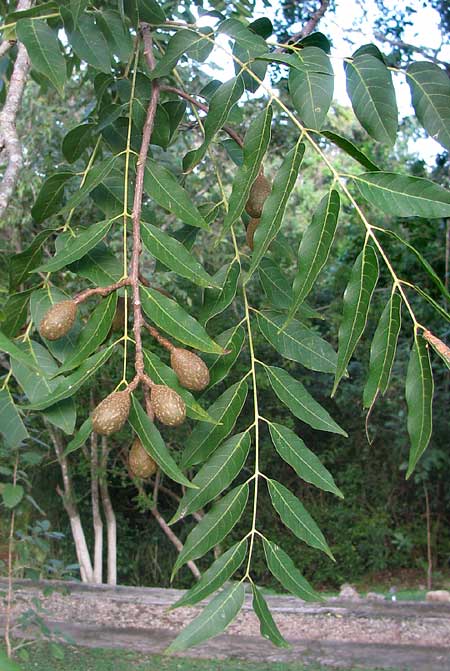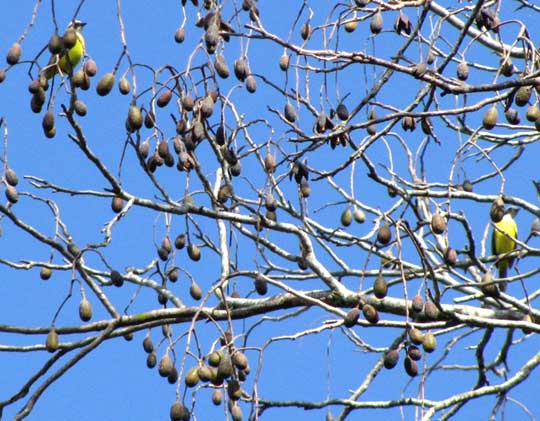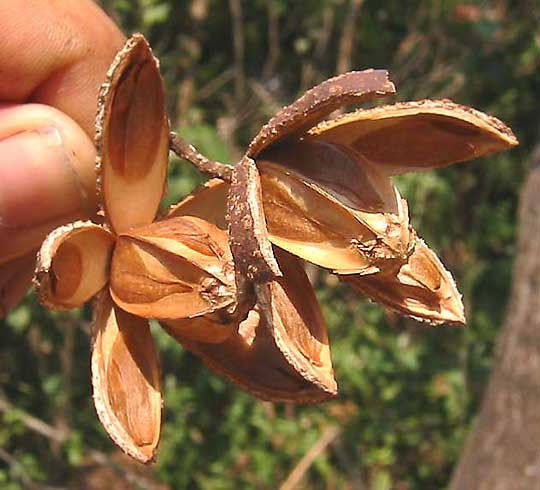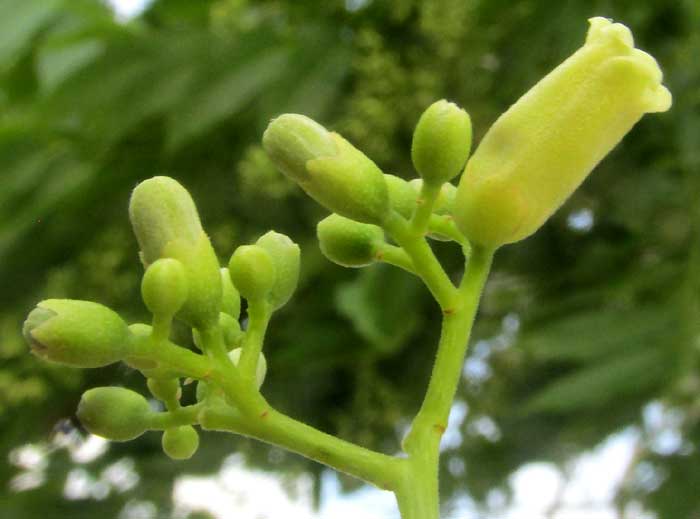Excerpts from Jim Conrad's
Naturalist Newsletter
from the November 15, 2009 Newsletter issued from Hacienda Chichen Resort beside Chichén Itzá ruins, central Yucatán, MÉXICO
CEDROS FRUITING
Now in November it's the end of the rainy season and Cedros are still fully leafed out. They flowered months ago so now they're laden with immature fruits. The tree's alternate
(one leaf per stem node), pinnately compound, walnut-like leaves and oval, brownish, 1.5-inch-long capsules (4 cm) are shown below:

Some time ago a branch of a big Cedro at the Hacienda fell off so they sawed the branch into thick boards, which they stored in the room I occupy now. What a pleasant, fresh, resiny odor that reddish wood emits, similar to that of the North's Redcedar or Juniper wood. For a bed I've strung my mosquito net atop two thick, reddish, odoriferous slabs of Cedro and when I sleep on them their odor in the moist night air is delicious, somehow cleansing. And the boards themselves are so thick and strong that I imagine them imparting into me some of their solidness and general magnanimous nature.
Because of the wood's strength, durability and pleasing look and odor, it is highly esteemed and costly, which has caused its demise in numbers in many places.
If you travel in the hot, humid lowlands of Mexico, Central America and the West Indies, this is a very handsome and noble tree you need to know.
from the February 27, 2011 Newsletter issued from Hacienda Chichen Resort beside Chichén Itzá ruins, central Yucatán, MÉXICO
OVAL FRUITS ON TREES
Here in the heart of the dry season many trees are completely leafless, though sometimes they bear flowers or fruits. Two of our largest, most common and conspicuous tree species nowadays are heavily laden with oval, nutlike fruits.
One is the Cedro, the other is the Ceiba.`You can see how thickly the cedro fruits hang on branches in which two Social Flycatchers nonchalantly perch below:

In that picture, notice that Cedro fruits are only a fraction of the flycatchers' size. On the Ceiba, the fruits are nearly the birds' same size.
from the April 28, 2008 Newsletter issued from Mexico's Southernmost State, CHIAPAS
CEDROS AFTER SEED-FALL
One of the most important trees of humid, tropical forests from Mexico to South America -- in rainy areas growing up to a hundred feet high (30 meters) -- is the Cedro, sometimes known in English as Spanish-Cedar. It's CEDRELA ODORATA of the Mahogany Family, the Meliaceae. Despite the big trees being leafless at this time they're still conspicuous on the landscape because of abundant fruits dangling at the ends of branches. The fruits split into star-shaped capsules and release papery, winged seeds, as shown below:

A close-up of some split-open fruits is below:

The word "cedro" means "cedar," but the Cedros here aren't similar to or related to the North's cedars, which are evergreen gymnosperms. The cedar connection probably comes about because Cedros's wood is similar to that of our northern cedars, being reddish and emitting a sharp, resiny odor.
Cedros have disappeared from large parts of tropical America because their wood is so prized, and often exported. The species shares many characteristics with closely related Mahogany. Both trees produce capsular fruits with winged seeds, both produce clusters of numerous, small flowers, and both bear pinnately compound leaves looking somewhat like northern walnut leaves. Mahogany leaves are evergreen, however, while Cedros lose their leaves during the dry season. Up North the best-known member of the Mahogany Family is the Chinaberry Tree, introduced from Asia.
issued June 1, 2020 from Tepakán, Yucatán, MÉXICO
CEDROS FLOWERING
Nowadays, as the rainy season's first rain appear, the Cedros are producing large panicles of yellowish flowers, shown below:

The flowers have a short calyx with 4-5 lobes and 4-5 petals, shown below:

A longitudinal section of a flower is shown below:
